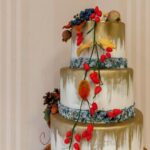Cake decorating is an intricate art form that has captivated bakers and dessert enthusiasts for centuries. From elegant wedding cakes to whimsical birthday creations, the possibilities are endless when it comes to adorning a cake with edible works of art. One exciting technique that has gained popularity among cake decorators is rolling a piece. This technique allows decorators to create unique and intricate designs that can transform any cake into a showstopping centerpiece.
When it comes to cake decorating, the skill of rolling a piece is considered indispensable for any cake decorator. This technique involves rolling out a piece of fondant or modeling chocolate into a thin sheet, which can then be used to create various shapes, textures, and designs on the surface of a cake. It requires precision, patience, and creativity to achieve perfectly rolled pieces that add depth and dimension to the overall design.
To successfully roll a piece for cake decoration, certain materials and tools are necessary. A smooth surface such as a silicone mat or marble board is ideal for rolling out the fondant or modeling chocolate. A rolling pin with adjustable thickness guides ensures that the desired thickness is consistent throughout the piece.
Additionally, cornstarch or powdered sugar may be used to prevent sticking during the rolling process. These essential tools, along with careful attention to detail, contribute to the success of rolling a visually stunning piece for cake decoration.
Intricate designs created with rolled cake pieces have become synonymous with modern cake decorating. Bakers have taken this technique to new heights by incorporating patterned rolls, marbled effects, and even hand-painted designs onto their cakes using rolled pieces. With endless possibilities and limitless creativity, mastering the art of creating elaborate patterns with rolled pieces allows decorators to showcase their skills and bring their culinary visions to life.
Rolling a piece in cake decorating may seem daunting at first, but like any skill in baking and pastry arts, practice makes perfect.
In our upcoming sections, we will provide you with a step-by-step guide to rolling a piece, explore different types of cakes suitable for this technique, offer tips and tricks on achieving perfectly rolled pieces, showcase stunning examples of cakes decorated with rolled pieces, and even answer frequently asked questions about rolling a piece in cake decorating.
So unleash your creativity, grab your tools, and get ready to impress with rolled cake decorations that will turn heads at any event or celebration.
The Importance of a Cake Decorator’s Skill in Rolling a Piece
Cake decorating is a beautiful art form that requires various skills and techniques. One important skill that cake decorators must possess is the ability to roll a piece. The rolling technique allows decorators to create intricate designs and add an extra dimension to their cakes.
The importance of a cake decorator’s skill in rolling a piece cannot be overstated. Rolled cake pieces can be used to add depth and texture to a cake, creating visually stunning effects that are sure to wow anyone who sees it. Whether it’s creating delicate flowers, elegant ruffles, or realistic-looking textures, knowing how to roll a piece opens up endless possibilities for creativity.
To successfully roll a piece, certain materials and tools are needed. A fondant roller is essential for evenly rolling out the cake into thin sheets. Cake decorators also need a firm yet pliable medium, such as fondant or gum paste, which can easily be rolled without tearing or cracking. Additional tools like shaping tools, cutting wheels, and molds may also be required depending on the specific design being created.
Developing the skill of rolling a piece takes time and practice. Cake decorators need to master the technique of rolling out the cake into smooth sheets that are free from wrinkles or air bubbles. They must also learn how to handle the rolled pieces with care so as not to damage or distort them during placement on the cake.
Step-by-Step Guide to Rolling a Piece
Rolling a cake piece is an exciting and versatile technique that every cake decorator should master. Whether you want to create intricate designs or add unique textures to your cakes, rolling a piece can elevate your creations to the next level. In this section, we will provide a step-by-step guide on how to roll a piece and the materials and tools you will need.
To begin rolling a cake piece, gather the following materials and tools:
- Cake: You will need a well-baked cake that is firm enough to be rolled without breaking apart. Sponge cakes or chiffon cakes work best for this technique due to their light and airy texture.
- Filling: Choose a filling that complements the flavor of your cake. Popular options include buttercream frosting, whipped cream, fruit preserves, chocolate ganache, or cream cheese frosting.
- Rolling pin: A good quality rolling pin is essential for evenly rolling out your cake piece. Opt for one with a smooth surface and comfortable grip.
- Parchment paper: Line your work surface with parchment paper to prevent sticking and make it easier to transfer the rolled cake piece.
- Offset spatula: Use an offset spatula to spread the filling evenly over the entire surface of the cake before rolling it up.
Now that you have all the required materials and tools ready, follow these step-by-step instructions:
- Step 1: Trim the edges of the cooled cake using a sharp knife to create straight edges.
- Step 2: Place a sheet of parchment paper on your work surface and dust it lightly with powdered sugar or cocoa powder to prevent sticking.
- Step 3: Transfer the trimmed cake onto the parchment paper with care.
- Step 4: Using an offset spatula, spread your chosen filling generously over the entire surface of the cake.
- Step 5: Starting from one end, gently roll up the cake into a tight log shape while peeling away the parchment paper. Apply even pressure as you roll to prevent the cake from cracking.
- Step 6: Once rolled, wrap the log tightly with plastic wrap and refrigerate for at least 1 hour to firm up the cake and filling.
With this step-by-step guide and the right materials and tools, you are well on your way to mastering the art of rolling a piece in cake decorating. Experiment with different flavors, fillings, and designs to create stunning cakes that will impress your friends and family.
Exploring Different Types of Cakes Suitable for Rolling a Piece
Cake decorators are constantly looking for ways to push the boundaries of their craft and create unique and eye-catching designs. One technique that has gained popularity in recent years is rolling a piece of cake. This technique involves rolling a thin sheet of cake into a tight log shape, which can then be used to create intricate designs and decorations on a cake.
While many types of cakes can be used for this technique, some are better suited than others. Sponge cakes are an ideal choice because they are light and airy, making them easy to roll without cracking or breaking. Genoise or chiffon cakes are also great options as they have a slightly denser texture that holds up well when rolled.
When choosing a cake for rolling, it’s important to consider the flavor and filling as well. Vanilla or chocolate sponge cakes work well as a neutral base for any design, while flavored sponges like lemon or orange add an extra burst of flavor. Filling options can range from simple buttercream or ganache to more complex fruit compotes or mousse.
To successfully roll a piece of cake, you will need a few essential tools and materials. Firstly, you will need a large baking sheet lined with parchment paper to bake your cake on. A thin layer of batter should be spread evenly on the sheet to achieve the desired thickness for rolling.
Once baked, allow the cake to cool completely before starting the rolling process. It’s also helpful to have a clean kitchen towel or silicone mat on hand for rolling the cake onto and removing any excess moisture.
In addition, a sharp knife or offset spatula is necessary for spreading fillings onto the rolled-out cake, while toothpicks can be useful for securing any decorative elements in place.
By exploring different types of cakes suitable for rolling a piece and being equipped with the right tools and materials, cake decorators can unleash their creativity and take their designs to new heights. Whether it’s creating elegant swirls and patterns or intricate shapes and figures, the possibilities are endless with this exciting cake decorating technique.
Mastering the Art of Creating Intricate Designs with Rolled Cake Pieces
Creating intricate designs with rolled cake pieces is a skill that takes practice and creativity. By mastering this art, cake decorators can elevate their designs to the next level, adding a touch of elegance and sophistication to their creations. In this section, we will explore the techniques and ideas behind creating stunning designs with rolled cake pieces.
Choosing the Right Design
The first step in creating intricate designs with rolled cake pieces is choosing the right design for your cake. Consider the theme of the event or occasion, as well as any specific requests from the client. Popular design options include flowers, geometric patterns, lace-like motifs, and even characters or objects. Sketch out your design on paper before starting to ensure you have a clear vision of what you want to achieve.
Preparing Your Cake Pieces
Before you begin creating your rolled cake pieces, it’s essential to prepare them properly. Start by baking a thin layer of sponge cake that will serve as your base. Once cooled, trim off any edges to ensure a neat rectangle shape. Next, apply a thin layer of buttercream or ganache to help adhere the rolled piece together and create a smooth surface for decorating.
Rolling Techniques
There are various rolling techniques that can be utilized when creating intricate designs with rolled cake pieces. One common technique is known as “log rolling,” where you tightly roll up a long strip of cake and chill it before slicing into thinner pieces.
Another technique involves cutting out shapes from a sheet of rolled-out cake dough and carefully placing them onto your base using edible glue or royal icing. Experiment with different rolling methods to find what works best for your desired design.
By mastering the art of creating intricate designs with rolled cake pieces, you can transform plain cakes into eye-catching works of art. Remember to practice patience and precision when working with these delicate decorations, as they require careful handling and attention to detail.
With time and experience, you will be able to create stunning designs that will impress both clients and guests alike. So get creative, unleash your imagination, and let your rolled cake decorations shine on your next masterpiece.
Tips and Tricks to Achieving Perfectly Rolled Cake Pieces
Choosing the Right Cake Recipe and Texture
One of the most important aspects of achieving perfectly rolled cake pieces is to start with the right cake recipe and texture. Avoid using cakes that are too dense or crumbly, as they will be difficult to roll without cracking. Instead, opt for recipes that produce a moist and fluffy cake, such as sponge or chiffon cakes.
Proper Cooling and Handling Techniques
Once your cake is baked, it’s crucial to allow it to cool completely before attempting to roll it. This ensures that the cake maintains its shape and elasticity when rolled. Place the cake on a wire rack to cool for at least an hour, or until it reaches room temperature.
When handling the cooled cake for rolling, make sure your hands are clean and dry. Dust a clean kitchen towel with powdered sugar or cocoa powder to prevent sticking. Gently invert the cake onto the towel and carefully peel off the parchment paper. If the cake sticks to the parchment paper, use a butter knife to help loosen it.
Rolling Techniques and Tools
To achieve beautifully rolled cake pieces, you’ll need some basic tools and techniques. First, use a sharp serrated knife to trim any uneven edges or crusts from all sides of the cake. This will ensure an even roll without any hard edges in your finished piece.
Next, spread a thin layer of frosting or filling over the entire surface of the cake. This helps prevent cracking during rolling by adding moisture and elasticity to the structure of the cake. Be sure not to apply too much filling as it can cause excess moisture and make rolling difficult.
To create a tight roll, use both hands to lift one end of the towel while gently pushing against the opposite end of the cake with your fingertips. Slowly start rolling tightly from one end using gentle pressure. Once fully rolled, use your hands to gently shape the cake into a cylindrical form.
By following these tips and tricks, you’ll be well on your way to achieving perfectly rolled cake pieces. With practice and patience, you’ll soon be able to create stunning decorations that will impress both visually and in taste.
Showcasing Stunning Examples of Cakes Decorated with Rolled Pieces
One of the most exciting aspects of cake decorating is the ability to create stunning and intricate designs using rolled cake pieces. This technique allows decorators to add dimension and texture to their cakes, taking them from ordinary to extraordinary. From elegant wedding cakes to whimsical birthday creations, rolled cake pieces can be used in a variety of ways to bring a unique touch to any occasion.
Here are some stunning examples of cakes that have been decorated with rolled pieces:
- Wedding Cake: A traditional white wedding cake adorned with delicate rolled fondant flowers cascading down each tier. The soft colors and intricate details of the flowers create a romantic and elegant look.
- Animal-themed Cake: A children’s birthday cake featuring an adorable zoo theme. Rolled cake pieces are used to depict different animals such as lions, elephants, and giraffes. The playful design adds a fun and whimsical touch to the cake.
- Art-inspired Cake: An artistic masterpiece created entirely out of rolled fondant. Vibrant colors and abstract shapes transform this cake into a work of art that is almost too beautiful to eat.
- Floral Garden Cake: A spring-themed cake adorned with realistic-looking flowers made from rolled gum paste. The lifelike details of the petals and leaves give this cake a fresh and vibrant appearance.
- Holiday Cake: A festive Christmas-themed cake decorated with rolled fondant snowflakes, presents, and candy canes. The use of different textures and colors creates a visually appealing design that captures the holiday spirit.
These examples demonstrate just how versatile rolled cake pieces can be in creating unique and eye-catching designs for any occasion or theme. Whether you’re going for an elegant look or a playful one, incorporating rolled pieces into your cake decoration repertoire will surely impress your guests.
| Example | Description |
|---|---|
| Wedding Cake | A traditional white wedding cake adorned with delicate rolled fondant flowers cascading down each tier. |
| Animal-themed Cake | A children’s birthday cake featuring an adorable zoo theme. Rolled cake pieces are used to depict different animals such as lions, elephants, and giraffes. |
| Art-inspired Cake | An artistic masterpiece created entirely out of rolled fondant. Vibrant colors and abstract shapes transform this cake into a work of art. |
| Floral Garden Cake | A spring-themed cake adorned with realistic-looking flowers made from rolled gum paste. |
| Holiday Cake | A festive Christmas-themed cake decorated with rolled fondant snowflakes, presents, and candy canes. |
Frequently Asked Questions (FAQs) About Rolling a Piece in Cake Decorating
As cake decorating continues to gain popularity, the technique of rolling a piece has become increasingly intriguing for both professional cake decorators and home bakers alike. However, many individuals still have questions about this unique method of cake decoration. In this section, we will address some frequently asked questions to provide clarity and guidance for those curious about rolling a piece in cake decorating.
Q: What is rolling a piece in cake decorating?
Rolling a piece is a technique where you roll out fondant or modeling chocolate to create thin sheets that can be used to decorate cakes. These sheets can be shaped and molded into various designs, adding texture and dimension to your creations. Rolled pieces are often used to create intricate details such as flowers, lace patterns, or sculptural elements on cakes.
Q: What materials and tools do I need for rolling a piece?
To successfully roll a piece, you will need some essential materials and tools including:
- Fondant or modeling chocolate: These pliable mediums are ideal for creating rolled pieces.
- Rolling pin: A sturdy rolling pin with smooth surfaces is essential to ensure even thickness while rolling out the fondant or modeling chocolate.
- Cornstarch or powdered sugar: Sprinkling cornstarch or powdered sugar on your work surface prevents sticking and makes it easier to handle the fondant or modeling chocolate.
- Cutting tools: You will need cutting tools such as sharp knives or pizza cutters to trim the rolled pieces into desired shapes.
Q: Are there specific types of cakes that are suitable for rolling a piece?
While not all cakes are suitable for rolling a piece technique, there are some types that work best due to their texture and sturdiness. Sponge cakes, chiffon cakes, and butter cakes are commonly used for rolled decorations because their crumb structure supports the weight of the rolled fondant or modeling chocolate without collapsing. It’s important to choose a cake with a firm texture that can withstand the weight and provide stability to your decorative elements.
| Question | Answer |
|---|---|
| What is rolling a piece in cake decorating? | Rolling a piece is a technique where you roll out fondant or modeling chocolate to create thin sheets that can be used to decorate cakes. |
| What materials and tools do I need for rolling a piece? | To successfully roll a piece, you will need some essential materials and tools including fondant or modeling chocolate, rolling pin, cornstarch or powdered sugar, and cutting tools. |
| Are there specific types of cakes that are suitable for rolling a piece? | Sponge cakes, chiffon cakes, and butter cakes are commonly used for rolled decorations because their crumb structure supports the weight of the rolled fondant or modeling chocolate without collapsing. |
Conclusion
In conclusion, the technique of rolling a piece in cake decorating opens up a world of creativity and endless possibilities. Whether you are a professional cake decorator or a passionate home baker, mastering this skill can take your creations to the next level. By following the step-by-step guide and utilizing the right materials and tools, you can achieve perfectly rolled cake pieces that will wow your friends and family.
One of the key aspects to remember when it comes to rolling a piece is practice. Like any other art form, it takes time and patience to hone your skills. Don’t be discouraged if your first attempts don’t meet your expectations. Keep trying, experimenting with different types of cakes suitable for rolling, and soon you will start creating intricate designs that will amaze everyone.
Additionally, don’t forget to incorporate your own personal touch into your creations. The beauty of cake decorating is that it allows you to unleash your creativity and showcase something truly unique. Use the tips and tricks provided in this article as a foundation, but feel free to experiment with different techniques and ideas. The more you explore and push the boundaries, the more impressive your rolled cake decorations will become.

Welcome to my blog about home and family. This blog is a place where I will share my thoughts, ideas, and experiences related to these important topics. I am a stay-at-home mom with two young children. I hope you enjoy reading it! and may find some helpful tips and ideas that will make your home and family life even better!





